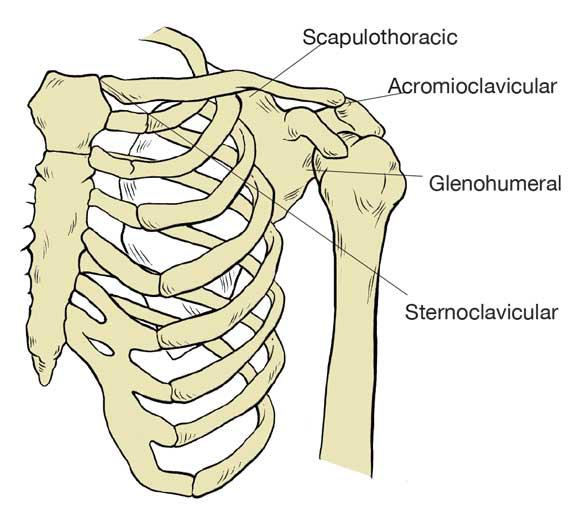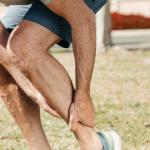Written by: Caitlin Perrett, M. Ost
If you’ve ever had a shoulder problem, you may well have heard professionals tell you how intricate and complicated it is to assess and treat.
If we asked you, what is the shoulder?
You would be forgiven in thinking of the ball and socket joint connecting the arm bone to the… well… shoulder bone?
And if I asked can you point to your shoulder?
You may well point to the rounding at the top of your arm, the part extending from your neck across, or the back, over where your shoulder blade is.
Now this is confusing, because it seems to be spread over a wide area of your body, and normally when we talk about joints, we are usually referring to just one.
But in the shoulder, we are actually referring to 4 different joints!

The 4 joints of the shoulder complex:
- The glenohumeral joint (ball and socket joint)
- The sternoclavicular joint (strut allowing arm to hang from the body)
- The acromioclavicular joint (strut)
- The scapulothoracic joint (stable base for movement)
On the whole, most shoulder injuries are related to overuse, rather than a single trauma, but either way the following principle applies to both scenarios.
PRINCIPLE: Fundamentally all shoulder issues arise because of one, or both, of these things:
- The ball (from the ball and socket joint), fails to be centred in the socket properly during movement
- The shoulder blade, which acts as a stable base for the ball and socket joint to move around, moves in an inefficient way on the thorax.
All problems relating to the shoulder complex will follow this principle. Whether you’ve been diagnosed with impingement, instability, muscle tendon issue like rotator cuff or biceps or bursitis. Whether you’ve had, or heard of any of these conditions, or not, it doesn’t matter.
Rehabilitation should aim to affect that principle and answer these questions:
- Is the ball centred in the socket? If is not, how can we get it to do that better?
- Are the shoulder blade and upper back working together, acting as a stable base for large arm movements? If they are not, what needs to be changed to help that area to do that better?
Sometimes, there are structural changes to the anatomy, which prevent these 2 things from being achieved, that’s where occasionally surgery or injections are necessary to help. However, even with the most profound tendon changes to the rotator cuff for instance, if we aim to answer the above questions, and improve overall function, the pain resolves. And normal movement is achieved.
This is where osteopathy excels.
We are encouraged from an early point in our training to observe how the body moves together, from the feet to the finger tips.
Identifying biomechanical disadvantages in the body, which could result in overuse somewhere, and then injury. Did you know that 50-80% of force produced through the shoulder actually comes from the trunk, legs and pelvis? That means, even if we can’t fully improve those 2 questions within the shoulder complex, if shoulder function relies on a well-functioning kinetic chain – that’s the whole body moving and working together harmoniously, we can still improve overall shoulder mechanics, and lessen pain, by working on improving how the rest of your body moves, and how strong it is.
In this shoulder example, being able to specifically look at the shoulder structures which could be symptomatic and overloaded, but also being able to identify how the rest of the body is facilitating this, is a highly valuable skill, and one that comes with positive results.
So, osteopathy can be very good at diagnosing specific symptomatic issues, but it also is excellent at identifying the chain reaction, which has led to a specific structure failing. So, don’t be surprised if you come in with a shoulder problem, and leave with exercises for your core and pelvis.
Our Barnes Clinic
Our clinic is located in Barnes, South-West London and is easily accessible by public transport.
For more information including parking and other practicalities see our Barnes clinic page
Book an Appointment
Booking an appointment with one of our therapists is quick and easy. There is no long waiting time and you don’t need a referral from your GP.










